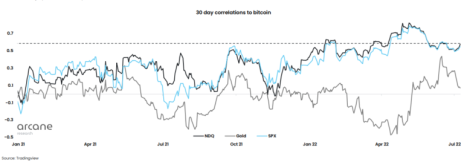After returning 340% in 2020 and another 48.5% in 2021, the price of Bitcoin (BTC)is down 60% so far in 2022 (and 70% off all-time highs). Most active market participants are calling for a “crypto winter,” which begs the question of what to expect from cryptocurrency investing for the remainder of the year.
At the risk of oversimplifying crypto trading conditions, the answer to that question likely boils down to one word: correlation.
More specifically, the correlation between the returns on Bitcoin and other top cryptocurrencies, such as Ethereum (ETH) or Solana (SOL), and the returns of the U.S. equity markets.

Learn More

Learn More

Learn More

Learn More
As you can see from the following chart, courtesy of Bitcoinist, the price of Bitcoin specifically (and other cryptocurrencies in general) has become increasingly correlated with equities, especially technology and growth stocks.
Just a few months ago we witnessed the highest correlation in years as both stocks and cryptocurrency were in the midst of a challenging selloff that saw both asset classes move in near lockstep (a correlation above 0.7). That’s dipped lately as crypto prices have failed to rebound during the most recent market rally, but some level of “decoupling” has not been unexpected.
Decoupling, in the parlance of the crypto trading market, simply translates to cryptocurrencies becoming uncorrelated (or inversely correlated) to other “risk-on” assets like speculative, high-growth stocks. An oft-cited vision of the cryptocurrency investing community is that cryptocurrencies will become an independent and self-sufficient economic system.
Realization of that vision would allow cryptocurrencies to serve as a true portfolio hedge against inflation and currency risk, but it’s not here yet, nor will it likely be for years. The regulatory environment remains too unclear, and the number of market participants is still too low to support a meaningful independent system.
Cryptocurrency Investing in 2022
For cryptocurrency investors, that means that price performance for the remainder of the year will likely remain tied to the performance of the equity markets and big investors’ appetites for risk. Meaningful price movement in crypto, then, would require enough of a bull market in stocks to prompt investors to scale up their risk tolerance and again increase their exposure to this highly speculative asset class.
There are, however, ongoing developments that could bring the vision of decoupling to fruition.
First up is the much-anticipated “merge” that will see Ethereum move from Proof of Work (miners solve complex cryptographic problems to create new ETH) to Proof of Stake (network validators stake (risk) their ETH to validate network transactions in exchange for transaction fees). The merge will significantly reduce the energy demands of the network (the Ethereum Foundation expects a reduction in energy use by 99.95%) while also reducing ETH emissions (the rate of production of ETH) substantially.
Those factors serve to increase the economic independence of Ethereum as they reduce costs associated with network participation (GPU (graphics processing unit) chips for mining, energy consumption) and increase ETH scarcity.
The second is increasing global participation. Continued worldwide adoption of cryptocurrency will subject it to fewer whims of localized markets (currently, 45% of Ethereum nodes are located in the U.S.).
But the most important development is the growth of dApps (decentralized applications). Most dApps in the current ecosystem are either DeFi (decentralized finance) or are trying to financialize otherwise mundane activities.
This is a logical extension of crypto as it digitizes money but is not yet an adequately attractive use case to prompt universal adoption, especially given the technical barriers to entry.
In essence, cryptocurrency projects need to produce applications that attract users or virtual/augmented spaces (metaverse, or metaverse adjacent) where people actually want to spend time.
A growing number of corporations have adopted Polygon (MATIC) to help fuel their forays into the metaverse, which makes it one of the more promising cryptocurrency investments for the remainder of the year. But success there becomes more company-dependent (MATIC would likely benefit from the successful launch of a Meta Platforms (META) metaverse, but META shares would benefit more).
The conservative cryptocurrency investing stance for the remainder of the year is to bet on platforms more than players (ETH, BTC, SOL). BTC has both the first-mover advantage and some intriguing applications as a “blockchain reserve” for market participants but lacks the features of ETH that make it an excellent platform to build on. SOL, on the other hand, boasts a higher transactions-per-second rate than ETH (pending the merge) but suffers from lower adoption rates and criticisms that it is too venture capital-dependent.
This leaves ETH as the most attractive option for those interested in cryptocurrency investing. There are, undoubtedly, other cryptocurrencies or Layer Two tokens that will outperform ETH on all timeframes, and ETH remains highly correlated to U.S. equities, but it remains the most promising Layer One token for sustained growth.

Sign up now!

Sign up now!

Sign up now!

Sign up now!

